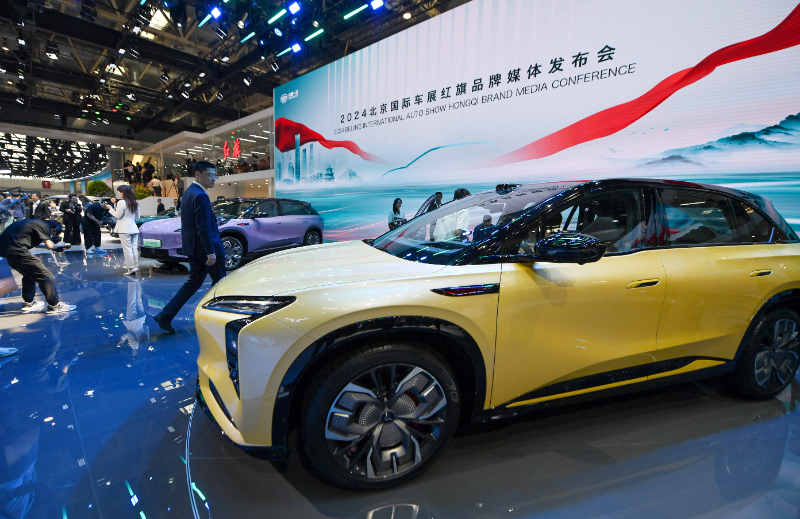
Automobile sales reached 14.047 million units, an increase of 6.1% year-on-year.According to data recently released by the China Association of Automobile Manufacturers (CAAM), the main economic indicators of China’s automotive industry showed a growth trend in the first half of this year, with particularly impressive performance in the new energy vehicle market.
Growth Trend in Key Indicators
In the passenger vehicle segment, from January to June, the cumulative production and sales of passenger vehicles reached 11.886 million and 11.979 million units, respectively, increasing by 5.4% and 6.3% year-on-year. Among the main categories of passenger vehicles, compared with the same period last year, the production and sales of sport utility vehicles (SUVs) showed double-digit growth.
In the commercial vehicle segment, from January to June, the cumulative production and sales of commercial vehicles reached 2.005 million and 2.068 million units, respectively, increasing by 2% and 4.9% year-on-year. Among the main categories of commercial vehicles, both passenger and goods vehicles showed varying degrees of year-on-year growth in production and sales. In terms of goods vehicles, medium-sized trucks had the most significant growth rate. For passenger vehicles, large and medium-sized buses had more pronounced growth rates.
Recently, at the 2024 China Automotive Forum held in Shanghai, Xin Guobin, Vice Minister of Industry and Information Technology, stated that in the first half of this year, China’s automotive industry developed steadily and made progress, presenting three major highlights: Firstly, automobile sales completed 14.047 million units, an increase of 6.1% year-on-year. Secondly, the electrification development reached a new level, with new energy vehicle sales accounting for 35.2% of total new car sales, an increase of 6.9 percentage points compared to the same period last year. Thirdly, the intelligent development embarked on a new journey, with 20 cities launching “vehicle-road-cloud integration” pilots and nine enterprises (consortia) conducting production access and road test pilots for intelligent connected vehicles. The sales proportion of vehicles with combined assisted driving functions exceeded 50%.
The relevant person in charge of the CAAM stated that currently, industry competition has further intensified, and business operating pressure has continued to increase. The overall industry operation still faces considerable pressure. Looking ahead to the second half of the year, the continuous implementation of favorable policies such as replacing old cars with new ones and promoting new energy vehicles in rural areas, as well as the dense launch of new products by enterprises, will help further unleash the consumption potential of the automotive market and provide support for the industry to achieve stable growth throughout the year.
Steady Improvement in New Energy Market Share
The performance of the new energy vehicle market was particularly impressive in the first half of the year. From January to June, the cumulative production and sales of domestic new energy vehicles reached 4.929 million and 4.944 million units, respectively, increasing by 30.1% and 32% year-on-year, and the market share reached 35.2%. “Over the past ten years since the association began keeping statistics, as of the end of June this year, the cumulative production and sales of domestic new energy vehicles exceeded 30 million units,” said Chen Shihua, Deputy Secretary-General of the CAAM.
In terms of drive forms, compared with the same period last year, the production and sales of pure electric, plug-in hybrid, and fuel cell vehicles all showed varying degrees of growth in the first half of the year. Among them, plug-in hybrid vehicles sold a total of 1.922 million units in the first half of the year, an increase of 85.2% year-on-year.
It is worth noting that in June, the market share of new energy vehicles reached 41.1%, marking the first time that China’s new energy vehicle market share exceeded 40%, indicating the rapid development and increasing maturity of China’s new energy vehicle market.
Fu Bingfeng, Executive Vice President of the CAAM, stated at the 14th China Automotive Forum that new energy vehicles maintained a good development.
Chinese Auto Brands Expand Overseas Presence
Chinese independent brands continue to increase their market share abroad. In the first half of the year, domestic new energy vehicle exports reached 605,000 units, representing a year-on-year growth of 13.2%.
Among the top ten vehicle export enterprises in the first half, BYD exported 207,000 vehicles, a 1.6-fold increase compared to the same period last year; Great Wall exported 202,000 vehicles, up 62.6% year-on-year; and Changan exported 285,000 vehicles, growing by 60.4% year-on-year. “Automobile exports are a significant growth point this year, and related companies have done a lot of work in developing international markets. Some enterprises have achieved rapid growth in the international market through long-term accumulation,” said Chen Shihua.
Investing in factory construction has become a crucial strategy for Chinese independent brands to seize overseas markets. Taking BYD as an example, it has invested in building factories in various overseas regions such as Brazil, Hungary, and Thailand, with its new energy vehicles now reaching over 400 cities in 88 countries and regions.
Chen Shihua stated that the overseas development of China’s automotive industry still faces numerous challenges. It is essential to strengthen the international influence of independent brands and gradually transition from being a large automobile country to being a powerful one. He suggested actively fulfilling corporate social responsibilities, supporting local development and construction, and continuously expanding overseas influence. Additionally, he emphasized the importance of enhancing international certification cooperation, promoting the mutual recognition of domestic and foreign standards, vigorously advancing the construction of overseas industrial parks, and selecting key countries and regions to establish automotive industrial parks. Furthermore, he advocated establishing marketing networks in key countries and markets and carrying out concentrated promotion of independent brand vehicles.


